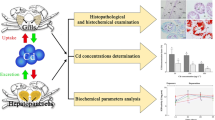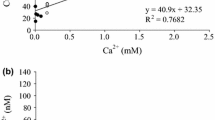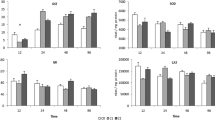Abstract
Studies on the freshwater crab Sinopotamon henanense have shown that acute and sub-chronic Cd2+ exposure induced differential alterations in the respiratory physiology and gill morphology. To elucidate Cd2+ toxicity under these two exposure conditions, crabs were acutely exposed to 7.14, 14.28, and 28.55 mg/L Cd2+ for 96 h and sub-chronically exposed to 0.71, 1.43, and 2.86 mg/L Cd2+ for 3 weeks. The Cd2+ accumulation, total metallothionein (MT), superoxide dismutase, and malondialdehyde (MDA) contents in the gill tissues were detected. Moreover, the glucose-6-phosphate dehydrogenase (G6PDH) activity, NADPH content, reduced glutathione (GSH), oxidized glutathione (GSSG), and GSH/GSSG ratio in the hepatopancreas were determined. The morphology of the X-organ–sinus gland complex was also observed. The results showed that sub-chronical Cd2+ exposure induced lower MT content and higher MDA level in the gills than in the acute exposure. In the hepatopancreas, acute Cd2+ exposure decreased the pentose phosphate pathway activity and NADPH content; however, an increased G6PDH activity and NADPH content were detected in sub-chronic Cd2+ exposure (2.86 mg/L). Morphological changes occurred in the sinus gland in crabs exposed to 2.86 mg/L Cd2+ for 3 weeks. The tightly packed structure composed by the axons, enlarged terminals, and glial cells, became loose and porous. Ultra-structurally, a large number of vacuoles and few neurosecretory granules were observed in the axon terminal. These effects added to our understanding of the toxic effects of Cd2+ and provide biochemical and histopathological evidence for S. henanense as a biomarker of acute or long-term waterborne Cd2+ pollution.






Similar content being viewed by others
Data availability
The data sets used and analyzed during the current study are available from the corresponding author on reasonable request.
References
Atli G, Canli M (2010) Response of antioxidant system of freshwater fish Oreochromis niloticus to acute and chronic metal (Cd, Cu, Cr, Zn, Fe) exposures. Ecotoxicol Environ Saf 73:1884–1889
Böcking D, Dircksen H, Keller R (2002) The crustacean neuropeptides of the CHH/MIH/GIH family: structures and biological activities. In: Wiese K (ed) The Crustacean Nervous System. Springer, Berlin, pp 84–97
Cheng L, Zhou JL, Cheng J (2018) Bioaccumulation, tissue distribution and joint toxicity of erythromycin and cadmium in Chinese mitten crab (Eriocheir sinensis). Chemosphere 210:267–278
Chung JS, Webster SG (2005) Dynamics of in vivo release of molt-inhibiting hormone and crustacean hyperglycemic hormone in the shore crab, Carcinus maenas. Endocrinology 146:5545–5551
Chung JS, Zmora N (2008) Functional studies of crustacean hyperglycemic hormone (CHHs) of the blue crab, Callinectes sapidus-the expression and release of CHH in eyestalk and pericardial organ in response to environmental stress. FEBS J 275:693–704
Chung JS, Bembe S, Tamone S (2009) Molecular cloning of the crustacean hyperglycemic hormone (CHH) precursor from the X-organ and the identification of the neuropeptide from sinus gland of the Alaskan Tanner crab, Chionoecetes bairdi. Gen Comp Endocrinol 162:129–133
Das S, Tseng LC, Chou C, Wang L, Souissi S, Hwang JS (2019) Effects of cadmium exposure on antioxidant enzymes and histological changes in the mud shrimp Austinogebia edulis (Crustacea: Decapoda). Environ Sci Pollut Res Int 26(8):7752–7762
Diaz-Flores M, Ibanez-Hernandez MA, Galvan RE (2006) Glucose-6-phosphate dehydrogenase activity and NADPH/NADP+ ratio in liver and pancreas are dependent on the severity of hyperglycemia in rat. Life Sci 78:2601–2607
Duangprom S, Kornthong N, Suwansaard S, Srikawnawan W, Chotwiwatthanakun C, Sobhon P (2017) Distribution of crustacean hyperglycemic hormones (CHH) in the mud crab (Scylla olivacea) and their differential expression following serotonin stimulation. Aquacultrue 468:481–488
He Y, Wang L, Ma W, Lu X, Li Y, Liu J (2019) Secretory expression, immunoaffinity purification and metal-binding ability of recombinant metallothionein (ShMT) from freshwater crab Sinopotamon henanense. Ecotoxicol Environ Saf 169:457–463
Irato P, Santovito G, Piccinni E (2001) Oxidative burst and metallothionein as a scavenger in macrophages. Immunol Cell Biol 79:251–254
Jing W, Lang L, Lin Z, Liu N, Wang L (2019) Cadmium bioaccumulation and elimination in tissues of the freshwater mussel Anodonta woodiana. Chemosphere 219:321–327
Kim BM, Jeong CB, Han J, Kim IC, Rhee JS, Lee JS (2013) Role of crustacean hyperglycemic hormone (CHH) in the environmental stressor-exposed intertidal copepod Tigriopus japonicus. Comp Biochem Physiol 158C:131–141
Klaassen CD, Liu J, Diwan BA (2009) Metallothionein protection of cadmium toxicity. Toxicol Appl Pharmacol 238(3):215–220
Lange A, Ausseil O, Segener H (2002) Alterations of tissue glutathione levels and metallothionein mRNA rainbow in trout during single and combined exposure to cadmium and zinc. Comp Biochem Physiol 131C:231–243
Lei W, Wang L, Liu D (2011) Histopathological and biochemical alterations of the heart induced by acute cadmium exposure in the freshwater crab Sinopotamon yangtsekiense. Chemosphere 84:689–694
Li Y, Wang L, Liu N, Wang Q, He Y, Meng F (2008) Effects of cadmium on enzyme activity and lipid peroxidation of Sinopotamon yangtsekiense. Acta Hydrobiologica Sinica 3:373–379
Li N, Hou YH, Ma DD, Jing WX, Dahms HU, Wang L (2015a) Lead accumulation, oxidative damage and histopathological alteration in testes and accessory glands of freshwater crab, Sinopotamon henanense, induced by acute lead exposure. Ecotoxicol Environ Saf 117:20–27
Li Y, Wu H, Wei X, He Y, Li B, Li Y, Jing W, Wang L (2015b) Subcellular distribution of Cd and Zn and MT mRNA expression in the hepatopancreas of Sinopotamon henanense after single and co-exposure to Cd and Zn. Comp Biochem Physiol 167C:117–130
Liu N, Yan B, Li Y, Wang L (2008) The effect of Cd2+ on the glutathione system of the freshwater crab Sinopotamon yangtsekiense. Environ Sci 29(8):2302–2307
Liu A, Liu J, Chen X, Lu B, Zeng C, Ye H (2019) A novel crustacean hyperglycemic hormone (CHH) from the mud crab Scylla paramamosa in regulating carbohydrate metabolism. Comp Biochem Physiol 231A:49–55
Lorenzon S, Francese M, Ferrero EA (2000) Heavy metal toxicity and differential effects on the hyperglycemic stress response in the shrimp Palaemon elegans. Arch Environ Contam Toxicol 39:167–176
Ma W, Wang L, He Y (2008) Tissue-specific cadmium and metallothionein levels in freshwater crab Sinopotamon henanense during acute exposure to waterborne cadmium. Environ Toxicol 23:393–400
Martinez-Finley EJ, Aschner M (2011) Revelations from the nematode Caenorhabditis elegans on the complex interplay of metal toxicological mechanisms. J Toxicol. https://doi.org/10.1155/2011/895236
Matić D, Vlahović M, Ilijin L, Mrdaković M, Grčić A, Filipović A, Perićeri oviić V (2020) Metallothionein level, non-specific esterases, fitness-related traits and integrated biomarker response (IBR) in larvae of Lymantria dispar (Lepidoptera) originating from unpolluted and polluted locations after chronic cadmium treatment. Ecol Indic 112:106136
May BA, Golding DW (1983) Aspects of secretory phenomena within the sinus gland of Carcinus maenas (L.). Cell Tissue Res 228:245–254
Medesani DA, López Greco LS, Rodríguez EM (2001) Effects of cadmium and copper on hormonal regulation of glycemia by the eyestalks, in the crab Chasmagnathus granulata. Bull Environ Contam Toxicol 66:71–76
Medesani DA, López Greco LS, Rodríguez EM (2004) Disruption of endocrine regulation of glycemia levels by cadmium and copper in the estuarine crab Chasmagnathus granulata. Bull Environ Contam Toxicol 73:942–946
Pedersen KL, Bach LT, Bjerregaard P (2014) Amount and metal composition of midgut gland metallothionein in shore crabs (Carcinus maenas) after exposure to cadmium in the food. Aquat Toxicol 150:182–188
Pierron F, Baudrimont M, Bossy A (2007) Impairment of lipid storage by cadmium in the European eel (Anguilla anguilla). Aquat Toxicol 81:304–311
Rhee JS, Yu IT, Kim BM, Jeong CB, Lee KW, Kim MJ, Lee SJ, Park GS, Lee JS (2013) Copper induces apoptotic cell death through reactive oxygen species-triggered oxidative stress in the intertidal copepod Tigriopus japonicus. Aquat Toxicol 132-133:182–189
Schafer FQ, Buettner GR (2001) Redox environment of the cell as viewed through the redox state of the glutathione disulfide/glutathione couple. Free Radic Biol Med 30:1191–1212
Schuwerack PMM, Lewis JW (2003) Cellular responses to increasing Cd concentrations in the freshwater crab, Potamonautes warreni, harbouring microbial gill infestations. Cell Tissue Res 313:335–346
Silvestre F, Duchêne C, Trausch G (2005) Tissue-specific cadmium accumulation and metallothionein-like protein levels during acclimation process in the Chinese crab Eriocheir sinensis. Comp Biochem Physiol 140 C:39–45
Sook Chung J, Christie A, Flynn E (2020) Molecular cloning of crustacean hyperglycemic hormone (CHH) family members (CHH, molt-inhibiting hormone and mandibular organ-inhibiting hormone) and their expression levels in the Jonah crab, Cancer borealis. Gen Comp Endocrinol 295:113522. https://doi.org/10.1016/j.ygcen.2020.113522.
Sun J, Liu A, Du Y (2001) Microscopic and ultrastructure of sinus glands of Eriocheir sinensis. Acta Zool Sin 47:27–31
Thornalley P, Vâsàk M (1985) Possible role for metallothionein in protection against radiation-induced oxidative stress. Kinetics and mechanism of its reaction with superoxide and hydroxyl radicals. Biochim Biophys Acta 827:36–44
Tian WN, Braunstein LD, Apse K (1999) Importance of glucose-6-phosphate dehydrogenase activity in cell death. Am J Phys Cell Phys 276:C1121–C1131
Vijayavel K, Balasubramanian MP (2006) Changes in oxygen consumption and respiratory enzymes as stress indicators in an estuarine edible crab Scylla serrata exposed to naphthalene. Chemosphere 63:1523–1531
Wang L, Yan B, Liu N (2008) Effects of cadmium on glutathione synthesis in hepatopancreas of freshwater crab, Sinopotamon yangtsekiense. Chemosphere 74:51–56
Wang L, Xu T, Lei W (2011) Cadmium-induced oxidative stress and apoptotic changes in the testis of freshwater crab, Sinopotamon henanense. PLoS One 6:1–8
Webster SG, Keller R, Dircksen H (2012) The CHH-superfamily of multifunctional peptide hormones controlling crustacean metabolism, osmoregulation, moulting, and reproduction. Gen Comp Endocrinol 175:217–233
Winzer K, VanNoorden CJF, Kohler A (2002) Glucose-6-phosphate dehydrogenase: the key to sex-related xenobiotic toxicity in hepatocytes of European flounder (Platichthys flesus L.)? Aquat Toxicol 56:275–288
Xu P, Guo H, Wang H (2019a) Identification and profiling of microRNAs responsive to cadmium toxicity in hepatopancreas of the freshwater crab Sinopotamon henanense. Hereditas 156:34
Xu L, Pan L, Zhang X, Wei C (2019b) Effects of crustacean hyperglycemic hormone (CHH) on regulation of hemocyte intracellular signaling pathways and phagocytosis in white shrimp Litopenaeus vannamei. Fish Shellfish Immunol 93:559–566
Xuan R, Wu H, Lin C, Ma D, Li Y, Xu T, Wang L (2013) Oxygen consumption and metabolic responses of freshwater crab Sinopotamon henanense to acute and sub-chronic cadmium exposure. Ecotoxicol Environ Saf 89:29–35
Xuan R, Wu H, Li Y, Wang J, Wang L (2014) Sublethal Cd-induced cellular damage and metabolic changes in the freshwater crab Sinopotamon henanense. Environ Sci Pollut Res 21(3):1738–1745
Yang HZ, Gu WJ, Chen W, Hwang JS, Wang L (2019) Metal binding characterization of heterologously expressed metallothionein of the freshwater crab Sinopotamon henanense. Chemosphere 235:926–934
Yang HZ, Wang L, He YJ, Jing WX, Ma WL, Chen CM, Wang L (2020) Analysis of spectrometry and thermodynamics of the metallothionein in freshwater crab Sinopotamon henanense for its binding ability with different metals. Chemosphere 246:125670. https://doi.org/10.1016/j.chemosphere.2019.125670
Yu D, Peng X, Ji C, Li F, Wu H (2020) Metal pollution and its biological effects in swimming crab Portunus trituberculatus by NMR-based metabolomics. Mar Pollut Bull 157:111307
Zhang X, Pan L, Wei C, Tong R, Li Y, Ding M, Wang H (2020) Crustacean hyperglycemic hormone (CHH) regulates the ammonia excretion and metabolism in white shrimp, Litopenaeus vannamei under ammonia-N stress. Sci Total Environ 723:138128
Zhou Y, Dahms HU, Dong F, Jing W, Wang L (2016) Immune-associated parameters and antioxidative responses to cadmium in the freshwater crab Sinopotamon henanense. Ecotoxicol Environ Saf 129:235–241
Zhou Y, Jing W, Dahms HU, Hwang JS, Wang L (2017) Oxidative damage, ultrastructural alterations and gene expressions of hemocytes in the freshwater crab Sinopotamon henanense exposed to cadmium. Ecotoxicol Environ Saf 138 L:130–138 Declarations
Acknowledgements
We would like to thank Editage (www.editage.cn) for English language editing.
Funding
The work was supported by the Natural Science Foundation of China (NO. 31272319), PhD Start-up Fund of Shanxi Medical University (NO. 03201552), and Youth Fund of Shanxi Medical University (NO.02201626).
Author information
Authors and Affiliations
Contributions
R.X participated in each experiment in the present study and completed the writing of the manuscript; H.W participated in the histological and ultra-structural examination of the X organ-sinus gland complex; Y. L participated in the determination of cadmium accumulation and MT content in the gill; B.W participated in the analysis of the data. The design, execution, data analysis of all experiments in this study, and manuscript writing and revision were completed under the guidance of L.W. All authors read and approved the final manuscript.
Corresponding author
Ethics declarations
Ethics approval and consent to participate
Not applicable
Consent for publication
Not applicable
Competing interests
The authors declare no competing interests.
Additional information
Responsible Editor: Bruno Nunes
Publisher’s note
Springer Nature remains neutral with regard to jurisdictional claims in published maps and institutional affiliations.
Rights and permissions
About this article
Cite this article
Xuan, R., Wu, H., Li, Y. et al. Comparative responses of Sinopotamon henanense to acute and sub-chronic Cd exposure. Environ Sci Pollut Res 28, 35038–35050 (2021). https://doi.org/10.1007/s11356-021-13230-z
Received:
Accepted:
Published:
Issue Date:
DOI: https://doi.org/10.1007/s11356-021-13230-z




